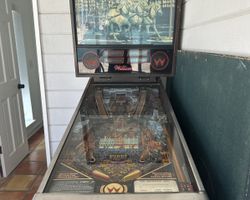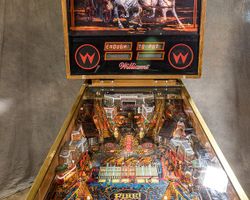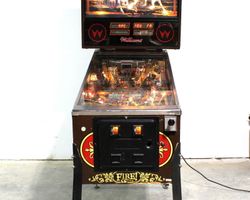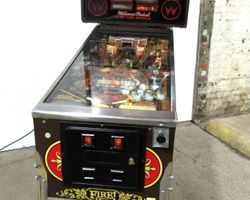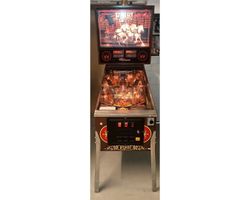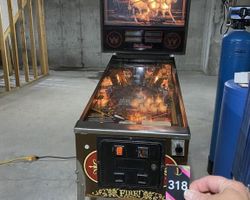Fire!
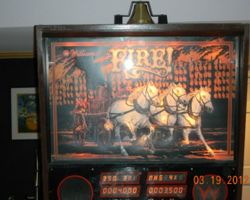
Average Prices: USD $500 to $1,900
Produced: June, 1987
Production Run: 7,700 units
Machine Type: Solid State Electronic
MPU: Williams System 11A
Players: 4
Design by: Barry Oursler
Art by: Mark Sprenger
Music by: Chris Granner
Sound by: Chris Granner, Brian Schmidt, Rich Karstens
Software by: Dan Lee
"Fire!", a distinct pinball machine released by Williams Electronic Games, Inc. in August of 1987, presented players with an urgent and immersive firefighting theme. Drawing inspiration from the dramatic imagery of a city ablaze, the machine sought to encapsulate the intensity and heroic efforts of battling a large-scale disaster. This theme, while seemingly straightforward, provided a rich canvas for both visual and mechanical innovation.
The creation of "Fire!" was a collaborative effort by a group of designers and artists within Williams. Barry Oursler took on the primary design role, shaping the fundamental gameplay and mechanical interactions. The machine's visual identity, a critical component of its appeal, was crafted by artist Mark Sprenger, who also contributed to the initial concept. Sprenger’s work on the playfield, with its detailed depictions of burning buildings and the intricate fleur-de-lis patterns, defined the game’s aesthetic. The immersive soundscape was a joint venture, with music composed by Chris Granner, and sound effects created by Brian Schmidt, Granner, and Rich Karstens, all working to enhance the fiery atmosphere. Dan Lee was responsible for the software, bringing the game's rules and interactions to life on the Williams System 11A platform.
"Fire!" entered production on June 3, 1987, with its first units shipping on June 26, 1987, quickly establishing its presence in arcades and game rooms. The main production run concluded on October 12, 1987, with approximately 7,700 units manufactured. This figure, derived from Williams' daily production logs, speaks to a significant release for the period. An interesting anecdote surrounds the game's start-up sound: the initial "moo" heard when a game begins is a nod to the apocryphal story of Catherine and Patrick O'Leary's cow being responsible for the Great Chicago Fire of 1871, a piece of folklore that has persisted despite being disproven. Another notable detail pertains to playfield variations; certain "black playfields" surfaced in the aftermarket, stemming from a large run of rejected units that never made it to the production line, confirming they were not an intended design choice by the artist. Furthermore, the design of the rollover cut-outs in the upper right playfield saw minor variations during production, a detail often attributed to practical modifications made by the silk screen printer to accommodate manufacturing processes.
Signature Features and Design
"Fire!" distinguishes itself with several unique elements that enhance its thematic presentation and gameplay engagement. Central to its visual appeal is a rotating color cylinder located beneath the playfield, meticulously designed to simulate the flicker and intensity of a building consumed by flames. This effect, visible through cutouts in the playfield, dynamically shifts colors and patterns, providing a constant visual reminder of the ongoing fire and the urgency of the player's mission.
Adding to the dynamic nature of the game are its three moving ramps. These mechanisms, including a prominent ladder ramp and two ramps protecting the horseshoe lanes, are not static pathways but instead raise and lower during gameplay, altering shot opportunities and adding a layer of strategic complexity. The ladder ramp, in particular, becomes a critical shot for multiball initiation, its elevation allowing a ball to enter an otherwise inaccessible elevated opening.
Auditory cues are equally important. A genuine brass bell mounted within the backbox rings out, signaling key moments in the game, such as a major score or the start of multiball, further immersing the player in the role of a firefighter. Below the main flippers, a pop-up ball save post provides a momentary reprieve, offering players a chance to prevent an early drain and extend their ball time, a classic Williams feature that adds a layer of recovery and excitement. The machine also features custom speech, providing thematic call-outs that guide and encourage the player, reinforcing the firefighting narrative. The alphanumeric display, standard for its generation, clearly communicates scores, multipliers, and game states, integrating seamlessly with the overall design.
Playfield and Mechanics
The playfield of "Fire!" is structured to reflect its theme, with major shots and interactive elements designed around the premise of extinguishing fires and rescuing civilians. It features two standard flippers at the bottom, complemented by four slingshots that propel the ball with force. Players navigate a field devoid of traditional pop bumpers or drop targets, relying instead on a configuration of fifteen stand-up targets positioned strategically as "fire targets."
The layout centers around various ramps and lanes. Two prominent horseshoe lanes, protected by the raising and lowering ramps, define the upper-mid playfield. These dynamic ramps lead to ball lock mechanisms, essential for building towards multiball. The main loop ramp sweeps around the back of the playfield, offering high-scoring opportunities and often enabling other features when lit. An upper playfield section houses a ramp that can elevate, providing access to an opening critical for engaging the game's multiball mode. Above this, a smaller horseshoe lane contributes to advancing bonus multipliers, which are clearly displayed in the storefront windows in the lower playfield.
The game begins with a manual plunger, allowing for a skill shot where players aim to send the ball through a series of five rollover sensors and a stand-up target, rewarding precision from the outset. While some find the symmetrical layout to present limited shot variety, the design philosophy encourages players to methodically address the "fires" that illuminate across the playfield. The artwork, characterized by its vibrant depictions of city buildings and fire effects, is widely considered a highlight, utilizing brown backgrounds for production units. Integrated lighting throughout the playfield emphasizes objectives and critical shot paths, enhancing the visual spectacle as players progress. A unique "fire plug" can raise between the flippers, providing a temporary ball save, triggered by successfully navigating the turnaround lane.
Gameplay Dynamics
The core gameplay loop of "Fire!" revolves around the urgent task of "putting out fires" strategically located across the playfield. Players achieve this by hitting specific banks of stand-up targets or making lit shots, with the objective illuminated by thematic inserts. A "Fire Multiplier," displayed prominently, dictates the value of points awarded for extinguishing these fires. This multiplier begins at 10x and progressively counts down (10x, 7x, 5x, 3x, 2x) each time a lit fire is not put out within a timed interval, injecting a palpable sense of urgency into every ball in play.
Progression in "Fire!" often funnels towards the 3-ball multiball, a central feature that offers significant scoring potential. To initiate multiball, players must "put out fires" on each of the designated building targets, which then lock a ball into that building. Once all balls are locked, shooting through the lower loop raises the critical ladder ramp. A precise shot up this elevated ramp and through the window initiates the intense multiball sequence. During multiball, the primary objective becomes putting out all remaining lit fires for a substantial one million-point award, demanding rapid and accurate shot placement under pressure.
Beyond the core fire-fighting and multiball mechanics, "Fire!" offers additional objectives. The "Save the Girl" mission is accomplished by hitting both "save the girl" ramps once, then making a subsequent shot to the now-lit "save the girl" ramp. Successfully navigating the turnaround shot, located at the back of the playfield, serves a dual purpose: it activates the "fire plug" ball save feature between the flippers and can also light the bonus multiplier or a special award. The bonus multiplier, which can reach up to 10x, is a key component for maximizing end-of-ball scores. These interconnected mechanics encourage a blend of strategic planning and rapid execution, making "Fire!" a game where consistent shot-making and managing the ticking "Fire Multiplier" are paramount to achieving high scores.
Reception and Legacy
"Fire!" generated a range of reactions within the pinball community, showcasing a machine that elicits both strong admiration and specific critiques. Many enthusiasts laud its visual presentation, consistently praising the artwork by Mark Sprenger as "gorgeous" and "top-notch," finding the fire-fighting theme to be well-integrated and genuinely captivating. The machine's sound design, particularly the distinct brass bell in the backbox and the evocative siren effects, often receives acclaim for enhancing the thematic immersion, with some describing them as "addictive" and perfectly complementing the urgent atmosphere. For many, the overall experience of "Fire!" evokes a sense of nostalgia, contributing to its unique charm and solidifying its place as a fun and engaging title.
However, "Fire!" also faces common criticisms. A recurring point of contention is the perceived repetitiveness of its gameplay. Some players find the shot variety limited, leading to a feeling that the objectives are too simple or that the game lacks depth over extended play sessions. While some appreciate the sound effects, the repetitive nature of the bell and sirens can become annoying for others, with some going as far as to suggest modifications to silence the bell. The playfield layout itself has drawn mixed feedback; while unique, some critique its symmetry and the presence of "ramps to nowhere," leading to impressions of an empty or overly simplistic design. Concerns have also been raised regarding the machine's build quality, with reports of wear and tear, particularly with the playfield plastics, suggesting a degree of fragility.
Despite these criticisms, "Fire!" maintains a distinct reputation within the pinball community. Its innovative use of a rotating color cylinder to simulate fire and its dynamic moving ramps were forward-thinking elements for their time, contributing to an engaging visual and mechanical experience. The machine is often considered accessible for beginner and moderate-level players due to its clear objectives, while still offering strategic depth through the "Fire Multiplier" and multiball progression for more seasoned players. Many in the pinball hobby regard "Fire!" as an underappreciated and underrated machine, perhaps overshadowed by some of its contemporaries but nonetheless a memorable entry in the Williams System 11A era. Its influence can be subtly observed in later games from Williams and Midway, particularly with the score display fire effects that reappeared in titles such as "Transporter the Rescue" and "Bugs Bunny's Birthday Ball," demonstrating how its visual innovations resonated within subsequent designs.
Sponsored Links
 Ebay Listings
Ebay Listings
 Auction Results
Auction Results
| Cost | Location | Date |
|---|---|---|
| USD $2,200 |  Pennsylvania, United States Pennsylvania, United States |
11 October, 2025 |
| USD $2,000 |  New Jersey, United States New Jersey, United States |
20 August, 2025 |
| USD $1,500 |  Oklahoma, United States Oklahoma, United States |
27 July, 2025 |
| EUR €1,065 |  Rheinland-Pfalz, Germany Rheinland-Pfalz, Germany |
25 November, 2024 |
| USD $5,495 |  Ohio, United States Ohio, United States |
06 November, 2024 |
| CHF $1,800 |  Switzerland Switzerland |
28 September, 2024 |
| USD $5,394 |  Texas, United States Texas, United States |
27 September, 2024 |
| USD $2,250 |  Minnesota, United States Minnesota, United States |
01 June, 2024 |
| USD $2,700 |  Pennsylvania, United States Pennsylvania, United States |
20 May, 2024 |
| USD $2,120 |  Arizona, United States Arizona, United States |
23 April, 2024 |


Private Policy · Search Website · Contact Us
As an eBay Partner, we may earn a commission from qualifying purchases made through links on this site, at no additional cost to you.
All trademarks and copyrighted materials remain property of their respective owners. All other content copyright 2007 - 2025 Pinpedia.

